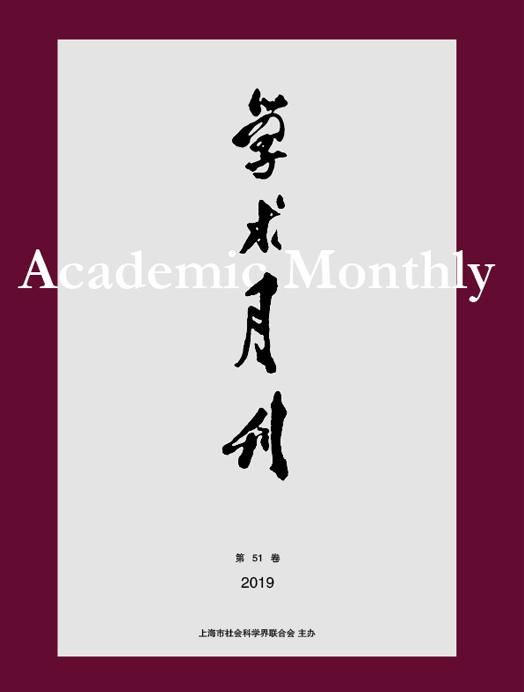Citation:
Xiaojiang ZHU. The Stylistic Features, Functions of Fictions and Their Relationship with May 4th Literary Reform[J]. Academic Monthly, 2021, 53(3): 160-169.

The Stylistic Features, Functions of Fictions and Their Relationship with May 4th Literary Reform
-
Abstract
Compared with the late Qing Dynasty, Liang Qichao’s article “On the Relationship between Fictions and Mass Governanceis” more closely related to the thoughts of May 4th generation. On the one hand, some of the issues raised in this article, including the re-understanding of the stylistic features of fictions, and the alternative and functional realization of the fiction writing content based on this new understanding, were still shared by the Zhou brothers, Chen Duxiu and Hu Shi when they discussed the construction plan of new literature, which providesthe ideological and logical starting point or even original point for the different exploration of new literature in the later new literature camp. On the other hand, Liang Qichao’s revelation of the characteristics of “yiren” (“移人”, re-understanding) in literature, and the construction of the author—reader and writing— reception community through the interpretation of “xun” (“熏”), “jin” (“浸”), “ci” (“刺”) and “ti” (“提”) with “emotion” as the link, provide practical direction and connotation for its independent role in the literature enlightenment project of the age, which is one of the bases for the formation of modern Chinese literary concepts.
-

-
References
-
Access
-
-
[1]
Yuan FENG
. Guo Shaoyu in Yenching University and the Institutionalization of New Literature in the 1930 s. Academic Monthly,
2020, 52(9): 140-149.
-
[2]
Yuefeng ZHOU
. From Revolution to Reform: Reorganizing The Emancipation and Reconstruction Semi-monthly and the Progressive Orientation of the Liang Qichao School. Academic Monthly,
2021, 53(12): 182-194.
-
[3]
Guiliang WEN
. The Practice of Literary Chinese and the Emergence of Modern Chinese Literature. Academic Monthly,
2021, 53(12): 139-150.
-
[4]
Haifei HUANG
. The Interaction between the Compilation of The Complete Works of Lu Xun and Philology of Modern Chinese Literature. Academic Monthly,
2021, 53(4): 152-161.
-
[5]
. . Academic Monthly,
2016, 48(04): 114-124.
-
[6]
. . Academic Monthly,
2016, 48(12): 111-121.
-
[7]
,
. . Academic Monthly,
2021, 53(12): 206-211.
-
[8]
Jianzhou FU
. Three Image Modes in the Picture Images of Modern Chinese Literature. Academic Monthly,
2021, 53(7): 168-178.
-
[9]
. . Academic Monthly,
2016, 48(01): -.
-
[10]
Daren LAI
, Yuanyuan ZHANG
. Literature of Human and the People’s Literature. Academic Monthly,
2021, 53(1): 172-182.
-
[11]
. . Academic Monthly,
2017, 49(04): 120-144.
-
[12]
Jin JIN
. The Differentiation of Overseas Chinese Community and the Literary Memories of a Pro-Reform Literati. Academic Monthly,
2019, 51(12): 133-141.
-
[13]
XIANG Jinglin
. Self-reporting and Voices: Plain Writing in Nonfiction Literature— A Case Study of Fan Yusu and Chen Nianxi. Academic Monthly,
2023, 55(5): 168-177.
-
[14]
Daren LAI
, Yuzhou ZHANG
. Discourse Construction of Theory of Chinese Literature Essence: Modern Generation and Contemporary Evolution. Academic Monthly,
2022, 54(11): 160-168, 206.
-
[15]
Congxue DUAN
. “Highway” as the Central Image in Literature in KMT Controlled Rigions and the Genesis of “National Sense of Community”. Academic Monthly,
2019, 51(7): 128-137.
-
[16]
LIU Andi
. The Research on the Shortening of Exile Distance in Song Dynasty. Academic Monthly,
2023, 55(8): 193-206.
-
[17]
Yi ZHAI
. The Transition of Relationship and Value between the Administrative Subject as Franchisor and the Object of Franchisee. Academic Monthly,
2019, 51(6): 78-93.
-
[18]
. . Academic Monthly,
2017, 49(12): 134-143.
-
[19]
. . Academic Monthly,
2023, 55(1): 138-153.
-
[20]
QI Weiping
. New Mission and New Narrative: The Discourse Creation of Modern Civilization of Chinese Nation. Academic Monthly,
2024, 56(2): 21-32.
-
-



 沪公网安备 31010102003103号
沪公网安备 31010102003103号 DownLoad:
DownLoad: